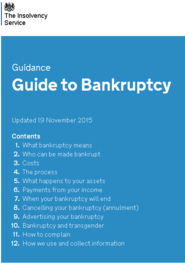The decision to take bankruptcy out of the courts is one of the reforms being made to ensure that people in financial crisis get swift access to the right insolvency remedy: we know from our own research that many people are intimidated by the idea of going to court and so will not consider bankruptcy, even though they are in financial crisis and urgently need debt relief. The new online form will be easier to access and use than the current paper application. |
|
 |
Applying for bankruptcy will still be a big step and one which people in financial distress generally only contemplate when they believe no other option is available to them.
However, we are trying to make the process as clear and straightforward as possible. People will be able to pay the fee online when they apply for bankruptcy, and will be able to pay by instalments (online payments only). The new adjudicator fee will be £130, replacing the current £180 court fee.
Applications for bankruptcy submitted online will be determined by an Adjudicator within the Insolvency Service. Once an order has been made, the case will transfer to the Official Receiver in the same way as it does in the current process.
The courts will accept any petitions made before or on 5th April 2016, regardless of the date of the hearing. No petitions will be accepted after 5th April 2016 but if a case is adjourned on or before 5th April 2016 it will continue to be dealt with by the court.
For more information, listen to this podcast we've recorded with the Money Advice Trust, explaining how the new online bankruptcy system will work.
 As many
people involved with insolvency will be aware, the Insolvency
Service is working to update the Insolvency Rules. The new Rules
will do three things:
- Incorporate various changes in the law, which are intended to reduce the burden of red tape;
- Consolidate
the existing rules and their amendments into a single set of rules; and
- Modernise
the rules through updating the structure and simplifying the language.
We are
currently working with the Insolvency Rules Committee to finalise the new Rules. We are making good progress and once we are through that
process our Minister, Anna Soubry, will
be in a position to decide on the commencement date for the new rules.
We have noted
what has been said about the need for sufficient lead in time between laying
the Rules and their commencement, and will provide further updates as soon
as we can.
|
 The Small Business, Enterprise and Employment Act 2015
included insolvency provisions which changed some of the primary legislation
around the UK’s insolvency regime; one of these related to how director
conduct is reported to the Secretary of State.
Conduct reporting is an essential element of the director
disqualification regime because it is the means by which cases are identified
for investigation, the final results of which are the disqualification
outcomes, which serve to protect the public by preventing people from abusing
the privilege of limited liability.
On 22 February 2016 the secondary
legislation was laid in Parliament which will enable the
Conduct Assessment Service, a new digital process, to replace a paper based
reporting system which has been in place since the 1980s.
The new Conduct Assessment Service will go live on 6th April 2016, when
the secondary legislation comes into force. This is an online tool which about 1,800 insolvency practitioners
and also the Insolvency Service’s Official Receivers will use to report on
director conduct.
The team developing the service has been undertaking user research, working closely with a variety of insolvency practitioners and their staff to
ensure that the service is suitable for use by firms ranging in size from
locally based, single practitioner businesses to global accountancy practices.
Conduct reports will need to be submitted within 3 months of the
company’s failure instead of the current 6 months. This will enable
investigations to commence at an earlier stage than they are at the moment and
should result in a reduction in the time taken to obtain disqualifications
where they are in the public interest.
The move to online reporting will simplify the process
for insolvency practitioners.
Reports on director conduct are required in respect of almost
all companies (with very limited exceptions) which go into a formal insolvency
procedure - in 2015 there were over 15,000 conduct reports required for corporate insolvencies. The legislative changes will reduce the
number of reports received by the new service as, for example, where the same
company is the subject of more than one type of insolvency procedure only one
report will be required under the new process.
Further communications about the Conduct Assessment
Service will be issued to insolvency practitioners over the next few
weeks.
|
 Over the
past few months – working with insolvency practitioners, other agencies and
regulators – our Investigation and Enforcement team have achieved
successes in tackling an array of company and individual misconduct.
Cases have
ranged from winding up a network of companies which sold over £36 million of
untradeable carbon credits as investments to unsuspecting members of the public, to achieving a 12 year disqualification for a wine merchant who sold wine which
didn’t exist.
Several recent
cases have involved disqualifications for directors for breaching employment
and immigration laws by employing illegal workers (e.g. at Bombay Blues
restaurant in Glasgow and the Golden Paragon restaurant in Newcastle) or
failing to pay the minimum wage (e.g. at Cygnets To Swans nursery in Manchester).
And in one
high-profile case in February, two directors of a holiday tour operator used by
Prince William and Prince Harry were disqualified for a total of 14 years; they
failed to ensure that several charities, including Sentebale (a charity founded
by Prince Harry and Prince Seeiso of Lesotho) and Nelson Mandela Children’s
Fund, received over £200,000 which had been raised for charity under commercial
participation agreements.
In some of the
most objectionable cases, we have clamped down on scammers targeting people –
often pensioners – who have already been tricked out of money once, claiming
they can recover losses, for a large advance fee. Our Investigation and Enforcement team also achieved a 10 year ban for the director of a
company which cold-called small businesses and individuals, duping them out of
hundreds of thousands of pounds on the grounds that the money would be used to
promote sexual awareness in young people.
The next set
of quarterly enforcement statistics will be published in May, but in the
meantime you can subscribe on GOV.UK to receive press releases about some
of our most significant enforcement successes.
|
 We have been looking at our funding regime to design a new, simple, transparent and
more resilient fee structure that would accord with the Government's ‘Managing Public
Money’ principles and place the Service on a more sustainable financial
platform.
More detailed information will be published in advance of any new
fee structure being introduced.
|
 The Insolvency Service is updating our online guidance.
Our recently
refreshed Guide to
bankruptcy has received 23,034 views in the first quarter since
publication. This is compared to 2,610 views of our old PDF guidance in the last
quarter before it was retired. The new plain English guide provides our
customers with full insight into what happens when they are bankrupt and has
been published in easily accessible web copy.
Work
continues on refreshing our other guidance documents and since the last edition
we’ve published the following new items:
Read our publications
refresh news story for further information.
|
|